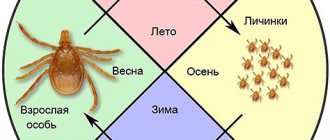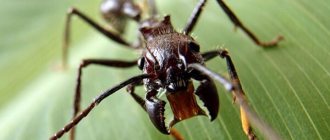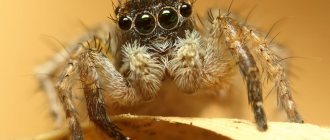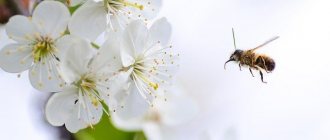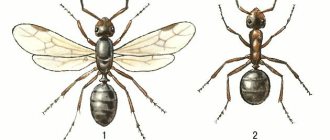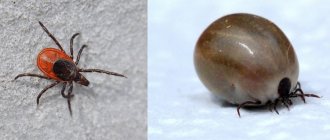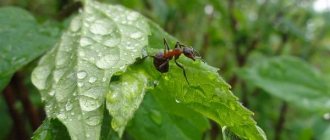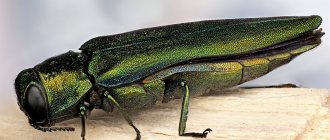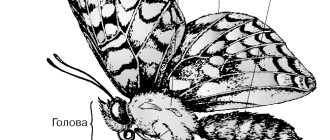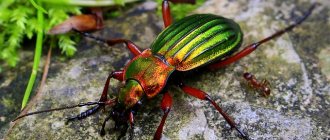Everyone has known ants since childhood. These creatures are characterized by labor-intensive abilities, thanks to which they carry objects many times the weight of their own body.
Also, many people know about the omnivorous nature of individuals living in natural conditions (forests, fields, vegetable gardens), as well as parasites that settle in human homes. Household pests are especially adapted to different types of food, making them quite difficult to eliminate.
Even if the apartment is kept perfectly clean, some housewives may find these insects in their kitchen and other rooms of the apartment. To understand the essence of behavior and survival of ants in different environmental conditions, you should understand what they prefer to eat in nature and at home.
Members of ant colonies
The inhabitants of the anthill are divided into 4 groups:
- Females (queens) are the founders of any ant house; their function is to lay eggs. There is only one female queen in the colony, which the ants carefully protect, feed and nurture.
- Males. They die some time after mating (their main function).
- Worker ants (foragers). Their responsibilities include caring for all members of the family, delivering food and protecting the anthill from attacks by enemies.
- Larvae. Future offspring. Larvae are divided into 2 types: those capable of feeding on their own and those requiring feeding. The latter species predominates; adult ants feed such larvae with semi-digested food from their own esophagus.
This entire large family needs huge amounts of food. What do ants eat?
Ant feeding frequency
Foraging ants
Insects feed more than once a day. Foraging ants do not miss the opportunity to have lunch along the way. Insects remaining at home also feed on stored supplies.
In addition to the owners themselves, other insects live in the anthill, such as beetles, caterpillars, moths and their larvae. The owners do not drive them away; they even allocate their eggs to them. In return, they feed on their syrup. To do this, you need to touch the tenant and he will release a little tasty syrup.
Oral apparatus
The mouthparts of these insects are “gnawing”. The mouth contains:
- upper lip (labrum) ;
- labia inferior (labium) ;
- mandibles (jaws) .
Depending on the species, the upper jaws (mandibles) and lower jaws (maxillae) can be: large and small, blunt and very sharp, with teeth and simply smooth, closing and overlapping. The mandibles have the ability to work independently even with the mouth closed.
The lower lip has a tongue, which is an organ of taste, and is also used by ants to clean their bodies.
House ants
Some nature lovers keep ants at home. They know that ants need food to develop. During the winter months they store their anthill in the refrigerator. The owners always leave food for insects in the insect feeder. When the temperature rises to zero, foraging ants run out and bring food to the anthill.
It is very important that there are trophic eggs in the anthill. They are laid by the queen during a period of abundance of food in the anthill. She uses undeveloped larvae for this. Ants feed on them when other food runs out.
Food
Ants are omnivorous insects. Their diet depends on the species and habitat.
During the warm season, food supply is carried out by worker ants daily. In cold weather, everything happens differently: many species of the ant family do not hibernate, and therefore in the fall they fill their home to capacity with food, this allows them to calmly survive the cold season.
REFERENCE! Ants love to drag into their home absolutely everything that gets in their way. And only then the food is distributed among the inhabitants of the anthill. To everyone's taste.
The distribution goes as follows:
- larvae. They feed on protein foods: the remains of small insects, eggs of various pests. If we are talking about domestic (pharaoh) ants, then the larvae often receive food from the table of the owners of the house (meat, eggs, cottage cheese, cheese), sometimes domestic cockroaches, which the younger generation also eats with pleasure, become the prey of the ants;
- worker ants. To maintain strength, they need carbohydrate foods that are nutritious, rich in energy and easily digestible. These are: the pulp of fruits and berries, seeds, nuts, roots and plant juices. Having settled in houses, they happily eat sugar and honey. The favorite delicacy of ants is honeydew (plant juice secreted by them during sudden temperature changes) and honeydew (sugar milk of aphids);
- uterus. The basis of her diet is protein. In many species, food intended for the queen is chewed by worker ants and supplied to their queen in a form convenient for consumption.
REFERENCE! For red forest ants, honeydew and dew make up almost 60% of the total diet.
They carefully guard aphids (milk cows), breed them on young shoots of trees, and take them with them to anthills for the winter.
Ants feed frequently , several times a day.
What do ant larvae eat?
Ant larvae, like the queen, receive mainly animal food. Protein food is necessary for their productive development, as it contains a large amount of microelements and vitamins. For feeding, workers bring them leftovers, eggs of small insects, aphids, and other food containing proteins.
If there is a lack of food, the development of the larvae slows down, which can lead to the adults eating them. This significantly reduces the population, so workers try to fully feed their offspring.
Ants eat depending on their type
There are species of gourmet ants that prefer 1-2 constant products to a varied diet:
- leafcutter ant . Insects of this species collect tree leaves in their home, carefully chew them into porridge and put them in special chambers. In the warm leaf mass there is a rapid development of fungi, which the leaf cutters feed on. The leaf blades themselves are too rough for their delicate stomachs and are not suitable for consumption;
- centromexes. They feed exclusively on termites;
- Dracula. These ants suck the juice of their own larvae, and the latter do not suffer much from this. Adult insects are engaged in catching large insects: spiders, centipedes, but they do not eat them themselves, but feed the younger generation;
- harvester ants. They feed on the seeds of dried plants. This food is not very digestible, so insects grind it into pulp with their strong jaws;
- carpenter ants . The source of carbohydrate for this species is tree resin, which is released in places where the bark is damaged;
- ponerins . This is a whole subfamily. Each species feeds on a specific insect pest. They are rightly called forest orderlies.
Ants are unique creatures. Tireless workers, they bring considerable benefits to forests, loosening the soil and destroying parasitic insects. True, ants often cause a lot of serious problems for people by eating seedlings, leaves and ripe root crops in their summer cottages or food supplies in their homes.
Ants in winter - how ants overwinter
In winter, the ant family is forced to starve. Ants living in Russia do not go into suspended animation, but are active in a closed anthill. Their meager food consists of previous reserves.
Reserves
In the south of Russia, harvester ants are capable of preparing about one kilogram of seeds of various herbs during the summer months. Then they will endure all the winter months calmly, there will be no hunger in the anthill. In winter, there are no larvae in the ant heap. Ants can do without the protein food that the larvae need.
Harvester ants primarily eat seeds, which make up up to 97% of their diet. Northern ants sleep throughout the 9 winter months. During hibernation they do not need food.
Photo
Pharaoh ant
Food for the ant
A species that has become completely at home with humans over the course of two centuries. The diet of pharaoh ants is no different from the human diet. Under natural conditions, indoor pests feed on the same things that their red-haired counterparts eat in the forest:
- plants' seeds;
- small invertebrates;
- insects and larvae.
But in the house these parasites become a real disaster. Their diet is expanding significantly. Foods that ants eat at home:
- bread;
- sugar;
- potato;
- cereals;
- oil;
- cheese;
- meat;
- sausage;
- sweets.
Naming what they don’t eat is much easier than listing everything that these insects eat. They are especially attracted to sweets as food. They are quite capable of eating only sweets, cookies, pastries and cakes.
At home, almost all types of ants become omnivores and feed on the same food as humans.
Description and characteristics
The anteater family includes two genera, three species and eleven subspecies, which differ in many respects. However, there are common features that are common to all species, including a very long tongue up to 60 cm long, a characteristic set of legs and a very strong tail that helps the animal climb trees.
The size of an adult animal may vary. Under natural conditions, males are larger than females. All anteaters have long, tube-shaped snouts, and have small, narrow mouth openings. The small size of the ears and eyes is also characteristic. The front five-fingered limbs have long and sharp, hooked claws. The hind legs have four or five toes with not too long claws. The entire body is covered with thick hair, which, depending on the species, can be short and soft or long and rough.
The hair coloring is quite contrasting. The color of the back varies from a gray tint to a relatively bright, golden-brown color. The abdominal area is most often yellowish or grayish-white. Four-toed anteaters have blackish stripes or a fairly large black spot on the body. The cranial bones are strong and elongated. Anteaters have no teeth, and their thin lower jaw is quite long and not powerful.
Development
The black garden ant, like any other, develops with complete transformation.
Lasius Niger named the first queen Izaura. Logic is clear: Niger, black, slave, slave Isaur. Such jokes) I will say that they are restless by nature. They run fast, but do not leave the cast. A colony of 50 individuals occupied a quarter of the small formicarium. However, if they escaped from the formicarium, it is difficult to catch them. They run fast and can't keep up.
Violent, warlike, but I didn’t see the spirit of a pioneer in them. Perhaps because the colony is small. They are also builders. He threw the medicine man's larva, and some oatmeal flakes came with it. They ground oatmeal flakes and built an arch. Sorry the photo didn't survive.
You can buy a black garden ant queen from us)
Source
Natural orderlies and pollinators
It’s not for nothing that scientists call them universal recyclers. By destroying waste and half-decomposed carcasses of animals in the forest, fields and near lakes, they cleanse the area of harmful substances. When they lay their eggs, they hatch into white larvae called maggots. These creatures are able to process all the surrounding garbage that was thrown out by humans or appeared as a result of animal activity.
There is a revealing story about how the famous scientist Carl Linnaeus set up an experiment and calculated with horror that the offspring of 3 dung flies could devour an entire dead horse much faster than the largest predator, the lion, could do.
Answering the question whether flies are needed in nature, scientists came to the conclusion that these insects are one of the links in the chain of interaction and circulation of substances in the environment. Their activities have a positive effect on environmental cleanliness and help get rid of human and animal waste. After which they themselves become prey - flies are quite high-calorie food, they are beneficial because they are actively eaten by many species of birds, as well as frogs and lizards, spiders and other representatives of the animal world.
A little about the digestion process of ants
In ants, the food organs are divided into the preoral chamber and the digestive tract. Under the lower lip there is a preoral chamber, which acts as a receiver for semi-liquid and liquid food, including various residues after cleaning the body. Here the food is “sorted” - everything edible goes into the mouth, and inedible particles are released in the form of small lumps.
The digestive tract is divided into anterior, middle and posterior sections. In the anterior one there is a crop, which acts as a “social stomach”, since food intended for the entire nest is stored in it. The process of digesting food occurs in the swollen midgut, called the stomach.
Ants are an integral part of the ecological chain. In nature they are of great benefit. But once settled in a house or on a plot of land, they become a big problem. The main enemies of pests are cleanliness and order!
Lasius niger (black garden ant): house maintenance, type of development, nutrition
Hi all.
Today I’ll tell you about the black garden ant (lasius niger). Keepers often start with it because it is the most accessible type in Russia. I myself acquired lasius niger immediately after the reapers. The black garden ant is a very tenacious species. It's hard to kill him. However, there are things that a colony will not survive. Read to the end so as not to make any mistakes. Brief information about Lasius niger:
- Wintering: yes;
- Years: June-August;
- Type of development: complete transformation;
- Nutrition: sugar syrup and protein feed;
- Size of individuals: workers: 3-5mm, males: 4-6mm, queen: 7-9mm;
- Humidity: ≈ 50-70%;
- Temperature: ≈ 22-25°C;
- Colony type: monogyne;
- Colony size: 10,000-100,000 individuals;
- Wintering: Recommended once every 2 years;
- Difficulty: Great for beginners.
